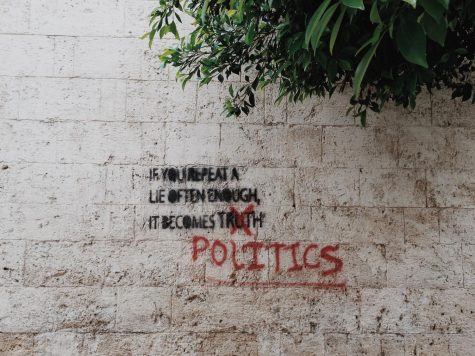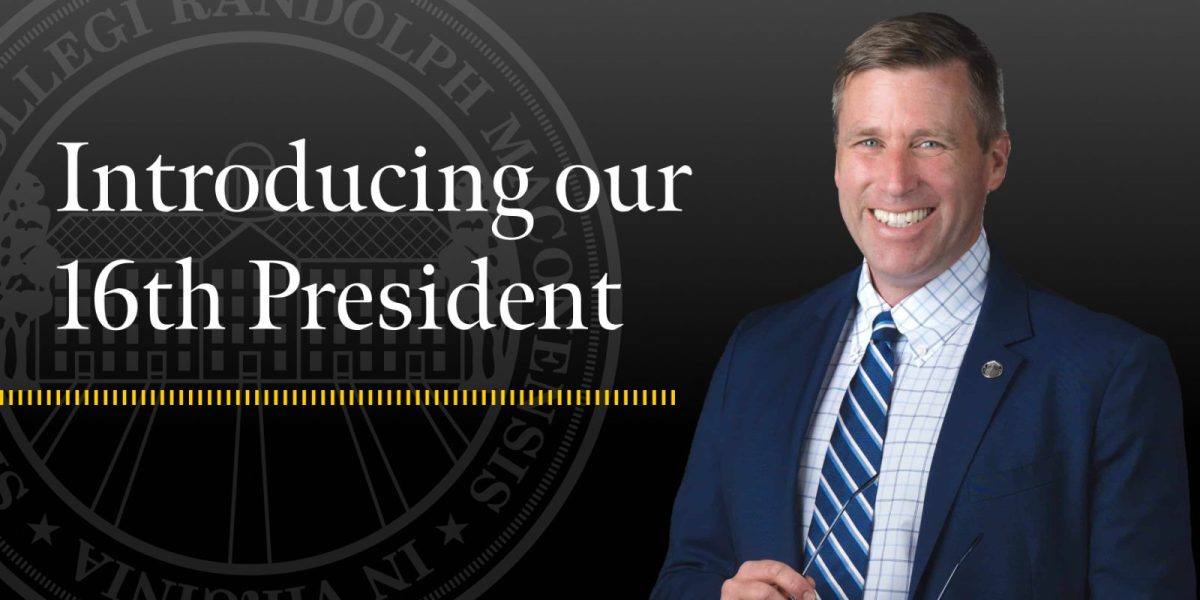The Noble Lie of the Mask
February 16, 2022
Notice: This article presents a controversial idea that is not affiliated with the Yellow Jacket Newspaper. We encourage open dialogue and welcome respectful responses from the R-MC community. If this is a topic you feel strongly on, please consider writing your own piece to be reviewed and possibly featured in our next release by emailing it to [email protected]. Thank you!
There is no scientific consensus that the use of cloth face coverings reduces the transmission of COVID-19. Despite this, the mainstream popular narrative surrounding masks claims that the efficacy of face coverings exists as an incontrovertible, settled fact. This popular narrative is endorsed by a massive apparatus of mainstream news networks, big tech, and government bureaucrats. The reality is that the science behind the introduction of cloth face coverings to reduce the spread of SARS-CoV-2 is anything but settled and has ultimately been utilized as a means of social control and pacification.
Any discussion around COVID policy or masks must begin from a place of humble scientific observation. It is from this observation, guided by human rationality, that we formulate opinions that most accurately reflect scientific knowledge. As it pertains to the efficacy of masks, the scientific knowledge is complicated and inconclusive. A recent review of the scientific evidence conducted by the CATO Institute (a highly credible libertarian-leaning think tank) found that “clinical evidence of facemask efficacy is of low quality,” and that of the sixteen analyzed studies, “eight were equivocal or critical as to whether evidence supports a public recommendation of masks, and the remaining eight supported a public mask intervention on limited evidence primarily on the basis of the precautionary principle” (Lui, Prasad, Darrow 2). In other words, the findings of these mask studies are inconclusive and do not align with the mainstream narrative.

A 2021 study conducted in Denmark with 4,800 participants found that there was no statistically significant difference in transmission rates between those who wore a mask and those who did not (Bundgaard). The CDC dismissed this study, calling it “inconclusive” and “too small.” Meanwhile, the CDC has shockingly decided to endorse the evidence of an observational study conducted among Missouri hairdressers with less than 200 participants. The CDC labels this observational study a landmark case and consistently uses it as an example of the science supporting mask mandates. As of writing this article, the CDC has since quietly admitted the fact that cloth face coverings are less effective at reducing the transmission of Covid (Chughtai). This recent update represents the first time the CDC has publicly admitted that mask efficacy can vary dramatically, which starkly contradicts the narrative they had been pushing for the previous two years. Evidence against cloth face masks had already existed for months prior to the CDC’s acknowledgment.
Another mask study conducted in 2015 discovered that surgical masks are “poor” at filtration, allowing 44% of pathogen-carrying particles. Comparatively, the same study found that cloth face masks let through an astonishing 97% of particles (MacIntyre). This viewpoint was previously held by Dr. Fauci himself, who, in a private email obtained through the Freedom of Information Act, stated that “The typical mask you buy in the drug store is not really effective in keeping out the virus, which is small enough to pass through the material.” One major problem with current widespread mask mandates is that they fail to discriminate between different types of masks, despite the wild differences in efficacy. Evidence even exists to support the idea that some forms of masks, such as Gaiter neck covers, increase the spread of particles (Fischer). These Gaiter face masks can function as a type of cloth shotgun, spreading the particles across a wider range. This is the same type of mask that was issued to RMC athletes last year and continues to enjoy widespread use on campus.
Furthermore, most of the mask studies are observational, meaning that they can fall victim to the correlation-causation fallacy. Fundamentally, we must recognize the possibility that wearing the mask causes people to behave in a more COVID-conscious manner, regardless of whether the mask itself actually works. Intuition tells us that in settings where
masks are voluntary, those people who chose to wear masks tend to be more COVID-conscious overall, resulting in a lower risk of transmission. A substantial portion of the scientific studies around mask efficacy fails to study the effect of masks segregated from other social safety policies such as social distancing. By studying the effectiveness of masks in conjunction with other public safety policies, these scientific studies fail to distinguish between the reduction in the transmission that results from masks as opposed to other social policies. Such studies, therefore, cannot substantiate the mainstream narrative that masks work isolated from other social policies.

One observation that remains consistent throughout the body of scientific literature is that N95 and KN95 respirators are highly effective at particle filtration and COVID transmission reduction. This scientific evidence, however, is a double-edged sword for the mainstream mask narrative. N95 rated respirators are so highly effective that they can be worn individually and provide substantial protection for the wearer, regardless of community mask status. This point of evidence runs counter to the mainstream mask narrative, which claims that masks must be worn collectively to protect wearers. From this point, the mainstream narrative claims that masks cannot be optional, as having a half-masked community defeats the point of anyone wearing a mask.
Based on the current state of scientific evidence regarding the efficacy of masks, it seems fitting to say that the widespread orthodoxy behind the mandating of masks is inaccurate. Instead, the so-called “scientific consensus” behind the forced masking functions as a type of noble lie, whereby the dominant bureaucratic ruling class keeps the public in line. The “scientific consensus” is a shadow on the wall, or a carefully constructed caricature designed to enforce and confirm the policies of the bureaucrats. Six months ago, any individual who doubted the efficacy of mask-wearing would be branded with the scarlet letter of being a “far-right conspiracy theorist.” That same mark of heresy would be branded onto any individual who suggested that natural immunity was stronger than the vaccine, that COVID began in a lab, or that there exists a distinction between deaths “from COVID” and deaths “with COVID.” All three of the previously listed statements have traveled from the land of “far-right misinformation” into the realm of commonly accepted scientific theory. The reality is that the mask exists primarily as a measure of social control, or an amulet designed to give people the illusion of security. For people in power, social control exists as an end within itself and requires no ulterior motive. Upon further reflection, there is not anything inherently wrong with giving people a noble myth to cling to during times of great social anxiety, so long as that myth remains subservient to the truth. In the case of COVID, however, the myth has killed the truth, and the majority of Americans are left chasing shadows.
*All photos from Unsplash.
References
Lui, T. Ian. Prasad, Vinay. Darrow, Jonathan. “Evidence for the Community Cloth Face Masking to Limit the Spread of SARS-CoV-2: A Critical Review.” The Cato Institute. Published November 8th, 2021. Last Accessed January 22nd, 2022. https://www.cato.org/working-paper/evidence-community-cloth-face-masking-limit-spread-sars-cov-2-critical-review
Bundgaard, H, and 21 other authors. “Effectiveness of Adding Mask Recommendation to Other Public Health Measures to Prevent SARS-CoV-2 Infection in Danish Mask Wearers.” Annals of Internal Medicine. Published March 2021. Last Accessed January 22nd, 2022. https://www.acpjournals.org/doi/pdf/10.7326/M20-6817
MacIntyre, R, and 9 other authors. “A cluster randomized trial of cloth masks compared with medical masks in healthcare workers.” PubMed.gov. Published April 22nd, 2015. Last Accessed January 22nd, 2022. https://pubmed.ncbi.nlm.nih.gov/25903751/
Fischer, E, and 6 other authors. “Low-cost measurement of face mask efficacy for filtering expelled droplets during speech.” Science Advances. Published September 2nd, 2020. Last Accessed January 22nd, 2022. https://www.science.org/doi/10.1126/sciadv.abd3083
Chughtai, A, and 2 other authors. “Effectiveness of Cloth Masks for Protection Against Severe Acute Respiratory Syndrome Coronavirus 2.” Center for Disease Control and Prevention. Published July 22, 2020. Last Accessed January 22nd, 2022. https://wwwnc.cdc.gov/eid/article/26/10/20-0948_article





















